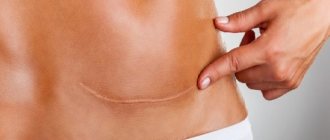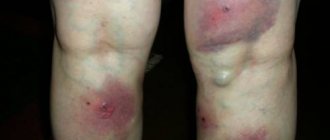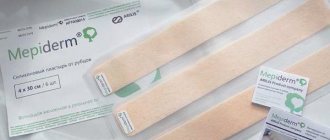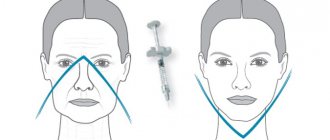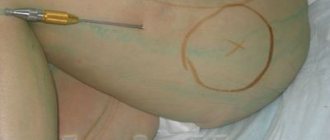Umbilical hernia is a disease most common in young children. Sometimes the umbilical ring does not close completely, and the baby is born with a hernial protrusion. In 9 out of 10 cases, such congenital hernias close on their own by 5 years.
Umbilical hernias are less common in adults. Unlike a congenital hernia, an acquired hernia will not disappear on its own. It increases over time and can lead to some complications. The only way to eliminate a hernial protrusion is surgical treatment.
Our expert in this field:
Sergeev Pyotr Sergeevich
Deputy chief physician for medical work, oncologist, surgeon, chemotherapist, doctor of the highest category, Ph.D.
Call the doctor
Indications for surgery
Emergency surgery to remove an umbilical hernia is performed in the following cases:
- Pinched hernia. This situation can lead to intoxication, disruption of cardiovascular and pulmonary activity. The patient experiences severe pain that does not go away until the tissue dies; the hernia cannot be reduced and becomes hard to the touch.
- Intestinal obstruction. The patient feels a contraction of the intestinal walls, but cannot have a bowel movement. He may be bothered by vomiting and severe pain. If measures are not taken, intestinal necrosis and acute peritonitis develop, which can lead to blood poisoning.
- Fetal hernias (hernias that occur before the formation of the fetal abdominal wall). In this case, the operation is performed on the first day after birth due to the high risk of necrosis. The exception is non-viable children.
In other cases, a planned operation is performed in the absence of contraindications. It is prescribed taking into account the patient's condition and needs.
In some cases, the doctor may insist that it be carried out as soon as possible. Even if there is no rush, it is better not to delay and perform the operation at the first opportunity.
Preoperative examination
Before surgery, a comprehensive examination of the patient is carried out to assess his somatic status. If necessary, correction is carried out to stabilize the patient’s condition. This measure is mandatory: it can significantly reduce the risk of complications.
Preoperative examination activities include:
- blood composition analysis (clinical and biochemical);
- study of the clinical composition of urine;
- tests for hepatitis, HIV, syphilis;
- electrocardiogram;
- coagulogram (blood clotting test);
- chest x-ray.
Contraindications
Surgery to remove an umbilical hernia is not performed in the following cases:
- Children's age (up to 5 years). In infancy, there is a chance that the hernia will disappear on its own as the body grows. Therefore, if it does not cause serious concern and has no complications, the operation is not performed or is postponed for several years. Important! We are talking only about noncongenital hernias.
- Infections in the active stage. The operation is a risk in this case, so it is performed after complete sanitation of the body.
- Incurable diseases. A hernia is not a dangerous disease, especially in the early stages. However, its removal poses a certain risk, which there is no point in exposing terminally ill patients to.
- Pregnancy in the second half. Any surgery is a stress for the body, which is best avoided by a pregnant woman. In the absence of serious health risks due to a hernia, surgery is postponed until the end of lactation or at least until the birth of the child.
- Stroke and heart attack. Anesthesia in this state is difficult to tolerate, so patients are usually not exposed to such risks.
- Disturbances in cardiovascular and pulmonary activity.
- Giant hernias in people over 70 years of age. In this case, extensive surgical intervention is required, which is poorly tolerated by older people.
- Liver cirrhosis with complications.
- Varicose veins of the esophagus.
- Diabetes due to lack of effect from insulin administration.
- Severe renal failure.
Important! Each case is considered by a doctor individually. Only a specialist should decide whether the potential effect of the operation outweighs the risks for the patient or not.
What physical therapy exercises can you do?
A physical therapy complex aimed at speedy recovery of the body after surgery may include basic gymnastic exercises that relax and strengthen the muscles of the abdomen, back and hips. All ab exercises are prohibited.
It is necessary to do similar gymnastics daily, dividing the entire complex into several approaches, each of which lasts 15-20 minutes.
Examples of various exercises are below, but it is better to discuss any exercises with your doctor:
Preparing for surgery
The patient must, within a month before planned surgery:
- Take blood and urine tests;
- Obtain from medical specialists in the presence of chronic diseases a conclusion on permission to perform the operation;
- Consult a gynecologist (women);
- Perform an ultrasound of the abdominal cavity;
- Undergo an endoscopy (esophagogastroduodenoscopy - “swallowing a tube”) or take an x-ray of the stomach;
- Perform fluorography and take an electrocardiogram;
- Get a therapist's opinion.
3 days before surgery you need to stop taking blood thinners. Before visiting a hospital or medical center, you must complete all hygiene procedures, it is advisable to shave your stomach and pubis (otherwise, this will be done by a nurse). In the morning you need to stop drinking and eating.
Do you want to get rid of a hernia quickly and permanently?
You're lucky to have found us. Contact us for advice.
- We will conduct an in-depth diagnosis of the condition of your abdominal cavity
- We will select for you the optimal treatment method from the entire range of modern high-tech surgical techniques
- Our highly qualified specialists - candidates and doctors of medical sciences - will perform the operation using the latest technologies, expensive specialized equipment and materials
- Your stomach will become healthy and beautiful, and traces of the intervention will be completely invisible to prying eyes
- We will carry out follow-up examinations and monitor your abdominal condition for six months to ensure there is no recurrence (free of charge)
Types of surgery and progress
Principle of surgery
The operation can be performed under conduction (into a vein) or local anesthesia (the area around the navel is injected). This point is discussed separately with the doctor. With conduction anesthesia, painful sensations are excluded, but after the operation the patient feels worse, attention is impaired, and weakness is present. For recurrent disease or emergency surgery, general anesthesia using an intratracheal tube can be used.
During planned surgery, hospitalization usually occurs on the day of surgery or the day before. You will have to spend 3 to 5 days in the hospital. The main surgical techniques are described below.
Rehabilitation period: timing and measures
Resort collage made of some beautiful pictures
To prevent the recurrence of an umbilical hernia, it is necessary to carry out proper rehabilitation measures. The patient must wear a bandage for six months, which prevents tension in the abdominal wall, especially in the first weeks after surgery.
Physical activity is recommended. This doesn't mean training in the gym. Activity involves walking at least 30 minutes a day in the fresh air.
Breathing exercises provide effective help. One of them is to inhale air through the nose at full force and exhale slowly through the mouth. Firstly, the entire body is enriched with oxygen through the lungs, and secondly, the abdominal muscles are gradually strengthened.
For people with weakened immune systems, it is important to include vitamins in their diet. Preference should be given to single drugs or complexes that are well absorbed. Some combinations of vitamins are not beneficial because they cancel each other out.
If you experience constipation after surgery, you should take a laxative. Preferably on a natural basis to avoid addiction. While the organs get used to the new location, the drugs will help improve the process of defecation.
Hernioplasty using Sapezhko, Lexer or Mayo methods
This is a traditional method of treating hernia in children over 5 years of age and adults. The various methods differ slightly in the location of the incision, the method of separating the hernial sac, and the placement of sutures. The choice is made based on the location and size of the protrusion.
After the onset of anesthesia, the surgeon makes an incision directly adjacent to the hernia. If it is small, then they try to preserve the navel for reasons of aesthetics of the patient’s appearance.
The surgeon peels off the hernial sac from the subcutaneous tissue. It is released, and the autopsy is performed in the cervical area (the actual opening from which the internal organs “fall out”). After this, the contents of the hernial sac (intestines, etc.) are “refilled” back into the body cavity. The neck is tied with silk threads. The hernial sac is removed. The fabrics are sutured in layers.
The recovery period is quite long and can reach one year. This technique is fraught with complications, the risk of which is higher than with minimally invasive interventions. Painful sensations persist for 2-3 months after surgery.
Why is it necessary to treat an umbilical hernia?
The very appearance of a hernia indicates that the organs have changed their location, and their normal mutual pressure on each other has been disrupted. This leads to disruption of the functions of all organs involved in the formation of a hernia.
An umbilical hernia must be treated. It cannot “drag out” on its own, and will only progress over time.
Without effective treatment, even a small hernia significantly impedes the normal functioning of organs
Lack of treatment will eventually lead to serious complications
- coprostasis - stagnation of feces in the large intestine,
- inflammation of the hernia - inflammation of the organs located in the hernial sac,
- strangulation of the umbilical hernia - sudden compression of the hernial contents in the hernial orifice, leading to disruption of the blood supply to the organs in the hernial sac, and as a result - necrosis (death) of tissue.
An umbilical hernia is often accompanied by chronic constipation. Constipation, in turn, leads to general intoxication of the body and can affect the condition of the entire gastrointestinal tract.
If a protrusion appears on the anterior abdominal wall, you should immediately consult a doctor, since it is much easier to treat a fresh hernia than one that has existed for a long time.
Surgery using mesh implants
The technique was put into practice about 30 years ago. It is carried out similarly to the previous method: during a planned operation, the contents of the hernia are immersed back into the abdominal cavity; during emergency intervention and detection of foci of necrosis, it is removed.
The main difference is that a mesh implant is sewn into the tissue . It relieves the body cavity of excess pressure and prevents the development of relapses. The mesh gradually becomes overgrown with its own tissues; it does not cause an immune response and does not decompose, since it consists of chemically inert, biocompatible materials.
The mesh endoprosthesis is fixed using special non-absorbable threads. They are made from prolene. More modern techniques involve the use of a stapler and securing the implant with tantalum staples. Abroad, the production of meshes with “Velcro” has begun, which simply need to be pressed onto the underlying tissues for fixation.
Tension-free hernioplasty
During such operations, the defect is closed using special materials. They are completely inert for the body and do not lead to an allergic reaction or rejection. Plastic surgery using mesh implants is the most modern and effective method of treating hernias. Some time after the operation (usually a week), the mesh begins to grow with the tissues of the body itself. A strong connective tissue barrier is formed at the operated site.
There are two main ways to install grids:
- It is placed above the aponeurosis, directly under the skin. The disadvantage of this method is the possibility of seroma formation (pathological accumulation of fluid under the skin layer), which significantly prolongs the rehabilitation period. Currently, this method is used very rarely - mainly in the case of an elderly patient, in the absence of the need for a quick return to active life.
- The second method involves implanting a mesh under the aponeurosis, into the deep layers of the abdominal wall - under the umbilical ring. This is the preferred way to fix the defect. It is practically free of flaws.
In case of significant defects of the abdominal wall, the presence of the so-called “second abdominal cavity phenomenon,” special preoperative preparation is often prescribed, the purpose of which is to increase the volume of the abdominal cavity and adapt the body systems to increased intra-abdominal pressure. Only after this is abdominal wall plastic surgery performed using a whole complex of polymer prostheses.
Their implantation is carried out using a special technique.
The main advantages of this method:
- maximum level of comfort;
- absolute elimination of the possibility of displacement of the prosthesis and re-development of the hernia;
- in case of divergence of the rectus muscles, the possibility of additional plastic surgery;
- increased degree of reliability in combination with all possible degrees of protection;
- minimal likelihood of nerve damage as a result of a small number of stitches;
- short rehabilitation period;
- possibility of using any type of anesthesia.
During umbilical hernia surgery, special threads are used that do not cause a reaction from the body.
Laparoscopic surgery
This type of intervention has additional contraindications. It is not recommended for:
- For immunodeficiencies, including HIV infection.
- In cases of liver dysfunction;
- During menstruation.
Most often, laparoscopy is used in combination with mesh implant prosthetics.
During the operation, the surgeon does not make an incision, but three small punctures. Special tubes called trocars are inserted into them. The largest is located in the navel area. This is where the endoscope with camera and light source is placed. The rest are filled with instruments for the necessary surgical procedures. A grabper is placed in one - a device for capturing tissue and delivering an implant. A suture device or stapler with staples is inserted into the other puncture.
laparoscopic method for removing umbilical hernia
After laparoscopy, the recovery period is much shorter than after standard surgery. This is associated with minor injury to muscle tissue and a reduced risk of damage to nerve endings.
Laparoscopy
One of the modern methods of treating umbilical hernia is laparoscopy. It began to be used about 15 years ago. The essence of the method is to create laparoscopic access to the abdominal wall. This method of suturing a hernial protrusion has all the advantages of minimally invasive surgery. This:
- no pain;
- minimal tissue trauma;
- minimum surgical intervention;
- excellent cosmetic effect;
- very short recovery period;
- low rate of relapses and complications.
This method is simply irreplaceable in the case of a combination of a hernia with other diseases of the abdominal organs, which also require surgical intervention. During the operation, modern video endoscopic technology, special materials and instruments are used to create ultra-thin sutures. According to many European experts, today the laparoscopic method of surgery is the gold standard in the treatment of umbilical hernia.
Contraindications to surgery are:
- immunodeficiency states, HIV;
- liver pathologies, hepatitis C;
- active phase of the menstrual cycle.
Complications
Most often, patients after surgery encounter the following complications:
- Wound infection. Hernioplasty is a “clean” (implies absence of contact with potential pathogens) operations, therefore antibiotics are not indicated after it. As a preventive measure, they are prescribed if a focus of infection has been detected or once for patients over 60 years of age.
- Seroma. This is swelling in the surgical site. Most often it occurs when using an implant as a reaction of the body to a foreign body. There are no signs of inflammation. Seroma resolves on its own within a few weeks. No treatment is required. However, it is necessary to visit a doctor and possibly do an ultrasound to rule out recurrence of the hernia.
- Hematoma is bleeding in the surgical area. Just like seroma, it can resolve on its own, but in most cases doctors prefer to open the wound and ensure fluid drainage.
- Neuralgia is a dysfunction of nerve endings. Complications occur in 10-15% of cases. Patients are concerned about pain, loss of sensitivity, burning and itching in the surgical area. Neuralgia, as a rule, goes away on its own within 6 months after the nerve endings are restored.
- Paresis (obstruction) of the intestine. To prevent it, drugs that enhance peristalsis are taken, the patient needs to perform physical activity, and in the first hours after surgery - breathing exercises.
What should people do if they notice postoperative signs of a hernia?
It is understandable that patients who have discovered a protrusion in the scar area are reluctant to return to surgery. However, the likelihood of more significant health consequences must be taken into account. During the examination, doctors will decide how to continue treatment and prevent complications.
Sometimes consultations are necessary to make a final decision
Conservative tactics are considered a method acceptable only in cases of obvious contraindications to repeated surgery (decompensation of the heart, internal organs, severe stage of chronic diseases). In such cases, patients are advised to:
- nutrition control;
- limiting physical activity;
- eliminating constipation with diet and medication;
- constant use of a special bandage.
Nutritional Features
In the presence of a hernia, food products should eliminate bloating, constipation, and indigestion. To do this, you will have to eat often, but in small portions. Should be excluded from the diet:
- all fatty, fried, spicy foods;
- pickled and salted vegetables;
- alcoholic drinks and carbonated water;
- strong coffee;
- various seasonings that stimulate acidity;
- solid food.
Shown: porridges, boiled meat and fish dishes, baked products, stewed vegetables, cottage cheese. To prevent constipation in the morning, it is recommended to take a tablespoon of vegetable oil, a few dried apricots or prunes. During the day you can drink alkaline mineral water without gas (Essentuki 4).
Is there an alternative to surgical treatment?
Official medicine claims that only through surgical intervention is it possible to remove a hernia. On the websites of traditional healers and their followers you can find different recommendations:
- Taking various herbal remedies.
- Reduction of the hernia and sealing it with a plaster.
- Taking plantain seeds.
- A compress made of clay or a mixture of honey, propolis and iodine, which must be applied to the hernia.
- Pouring with cold water or cold water and vinegar.
Doctors warn that none of these methods have scientific basis. Moreover, delay can be dangerous, since there is always a risk of strangulation of the hernia and the development of necrosis. At the first diagnosis, it is necessary to start planning the operation, and not waste time on ineffective and dubious means.
Only in children can the disease go away on its own. Remember, an umbilical hernia in adults cannot be cured without surgery!
Rehabilitation period
For planned operations and uncomplicated hernias, the recovery period is easy. The patient can take food the next day after surgery. At first, it is better to give preference to easily digestible foods in liquid or semi-liquid form. With traditional hernioplasty, turning in bed is allowed on the second day, and on the third day you can get up and walk a little.
Surgeons of the old school sometimes recommend long-term bed rest - up to 2 weeks. Modern experts call this tactic erroneous. So, Doctor of Medical Sciences V.V. Zhebrovsky notes: “Early physical activity of the patient prevents the occurrence of thromboembolism, pneumonia and other complications from the cardiovascular and respiratory systems of the patient.” Many foreign surgeons share the same opinion.
The diet should be maintained for up to 2 weeks. It is possible to prescribe a course of analgesics to relieve pain symptoms. A bandage or special underwear may also be recommended during the recovery period. They prevent the risk of relapse. Women can use a support belt for pregnant women as a bandage after surgery - its effect is similar.
Cardiovascular and pulmonary insufficiency may occur in the first hours or even days after surgery in patients with giant hernias or in elderly patients. To prevent this, they must take a position in which their head is higher than their feet and breathe in humidified oxygen. In some cases, artificial ventilation may be required.
Rehabilitation of patients with strangulated hernia, who underwent urgent or emergency surgery, is difficult. To prevent the development of purulent inflammation, they are shown:
- Wearing a tight bandage.
- Daily inspection of the wound, dressings,
- Punctures for the development of seroma or hematoma.
- A course of antibiotics.
- Use of physical therapy.
After discharge, all patients must observe restrictions on physical activity (up to 4 months). Return to work is possible 4-6 weeks after surgery. If the job involves heavy physical labor, a transfer to another position is necessary. It is possible to apply for disability.
Video: features of the postoperative period
Diet
Recovery after umbilical hernia surgery will be high-quality and fast if you follow nutritional rules for up to 3 months. This is exactly the period when internal and external seams will no longer be at risk.
Diet after umbilical hernia surgery is a separate, very serious topic. Most patients, as soon as they have the opportunity to move and choose their own food, forget about caution.
Patients should know what they can eat after umbilical hernia surgery, how often to eat, and what foods are strictly prohibited in the first days.
It is important to know the basic rules of nutrition:
- Eat 4-5 times a day, in small portions;
- Monitor the quality of the diet, the balance of necessary elements in them;
- Avoid complex dishes;
- Avoid fatty and spicy foods and snacks;
- Avoid fried and baked foods;
- Minimize or avoid consuming dairy products;
- Avoid alcohol.
Opt for boiled, stewed or steamed vegetables. Avoid foods such as potatoes, cabbage, and legumes - they lead to excessive gas formation, and this can damage the postoperative area.
To improve gastric motility, choose foods rich in carbohydrates, less fat, and low in protein.
What can you eat after umbilical hernia surgery:
- In the first days it is better to stick to liquid food;
- Fruits and vegetables rich in fiber;
- Buckwheat without milk;
- Egg;
- Lean meat;
- Fish.
You need to return to your usual food carefully, introducing complex dishes into your diet only 2–3 weeks after surgery. Some weight loss will be beneficial, and the recovery period will be significantly reduced.
You should exit the postoperative diet slowly and start eating more complex foods in small quantities. The following rules must be followed:
- Maintain a balance of proteins, fats and carbohydrates;
- Give importance to fortified, healthy food;
- Be sure to have a liquid lunch once a day;
- Monitor gastric emptying and avoid constipation;
- Avoid alcohol and cigarettes, since the condition of blood vessels is the main condition for a quick recovery.
Umbilical hernia surgery and the postoperative period will be easy if proper nutrition, both before and after surgery, becomes your habit.
Reviews from patients and doctors
Patients who do not have complications usually tolerate the operation well. They note that you can get up soon and quickly return to normal life and work. Some find it difficult to decide on surgery; they try to find alternative methods. Those patients who have gone through this procedure are advised not to delay.
The main fear among women is the cosmetic effect; their worries are related to how the stomach and navel will look after surgery. Not everyone is satisfied with their appearance after hernia removal. Stitches and scars can look unsightly. Men are less interested in this issue; they are more concerned about restoring performance and radically solving the problem.
Reviews regarding the installation of a mesh implant are very different. Some doctors advocate its use in any situation to prevent relapse. Others are skeptical about such an innovation and suggest its use only in cases of repeated hernia or weak, flabby abdominal muscles.
The choice of anesthesia is decided by the patient together with the doctor. There are supporters of both local and general anesthesia. In their reviews, some patients talk about unpleasant sensations during surgery when they are conscious.
Children, as a rule, respond normally to both surgery and anesthesia . Parents are much more worried. Children's impressions of a hernia removal remain the same as from a regular hospital.
Cost of surgery, receiving services under the compulsory medical insurance policy
Hernia removal is performed free of charge using standard methods. You will have to pay separately for the installation of a mesh prosthesis. Its cost is from 5,000 rubles, depending on the country of origin.
Laparoscopy with one day of hospitalization in Moscow costs 25,000 - 40,000 rubles. When using a mesh prosthesis, the cost of the operation will be about 50,000 rubles in the capital.
Important! In some private clinics, the patient may be discharged home on the day of the operation, since hospitalization makes the service much more expensive. This outcome is extremely undesirable. At first, specialist supervision is necessary.
Surgery for umbilical hernia is a necessary measure. Therefore, you should not wait; if you suspect a disease, you should contact a specialist and discuss future surgery. In order to choose a method, type of anesthesia, a suitable clinic or hospital, it is better to consult a trusted doctor. As experience shows, this factor turns out to be much more important than the fame and popularity of a specialist.
What is the most effective method for removing an umbilical hernia?
Our surgeons are fluent in endoscopic technology, but this technique is not always applicable for complex hernias. Often, much better results can be achieved by open hernioplasty.
Based on many years of experience in hernia repair, our surgeon will choose the optimal access method based on the characteristics of your particular disease.
The main factor in the successful outcome of hernia surgery is its impeccable technical execution. Poor surgical technique can ruin any method, even the best one. If all stages of the operation are performed correctly, then with any type of access the probability of hernia recurrence is minimal.



